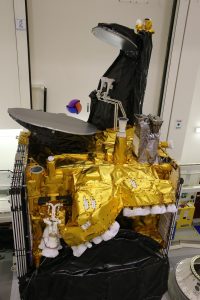
The GOLD instrument (the gray and white object located on the front right corner of the top deck) has completed environmental testing and is shown here on the SES-14 spacecraft in preparation for a scheduled January 2018 launch date. (Courtesy Airbus)
NASA’s Global-scale Observations of the Limb and Disk, or GOLD, instrument has successfully completed environmental testing at Airbus in Toulouse, France, in preparation for its groundbreaking mission to observe the nearest reaches of space. Scheduled for launch in late January 2018, GOLD will measure densities and temperatures in Earth’s thermosphere and ionosphere.
GOLD is a NASA Mission of Opportunity that will fly an ultraviolet imaging spectrograph on the SES-14 geostationary commercial communications satellite, built by Airbus for SES. The two-channel imaging spectrograph will explore the boundary between Earth and space, a dynamic area of near-Earth space that responds both to space weather from above and to weather in the atmosphere from below.
During the environmental testing phase, the 80-pound instrument underwent a variety of rigorous electrical, mechanical, and thermal tests that simulate the vibration and noise it will experience during launch, and the vacuum and extreme temperatures it will experience in orbit during the mission.
“The assembly, integration, and testing of the GOLD instrument has gone extremely well for us and is a testament to the professionalism of the GOLD, SES, and Airbus teams,” said Rory Barrett, GOLD project manager at the University of Colorado Boulder’s Laboratory for Atmospheric and Space Physics, or LASP. “Many members of the GOLD team have traveled to Toulouse repeatedly over the past 12 months and without their support a project like this would not be possible. Successful completion of integrated environmental testing is a major milestone, as these tests are conducted to help ensure the spacecraft and its payload can operate in the extreme conditions of space during the GOLD mission.”
Currently, the SES-14 spacecraft—on which GOLD will fly as a hosted payload—is being prepared for shipment to the Arianespace launch site in Kourou, French Guiana.
As the first NASA science mission to fly as a hosted payload on a commercial communications satellite, GOLD will collect observations over the western hemisphere with a 30-minute cadence, yielding an unprecedented amount of coverage. As a result, GOLD will be the first mission able to study the day-to-day weather of the thermosphere and ionosphere, rather than just its long-term climate.
“The GOLD team has designed, built, and successfully tested a fabulous instrument for making the measurements,” said Richard Eastes, GOLD principal investigator from the University of Central Florida’s Florida Space Institute. “We’ve got an exciting science mission planned, and the rigorous testing program we’ve completed ensures that the instrument is ready for launch and for successfully collecting science data.”
Geomagnetic storms driven by the Sun cause changes in the near-Earth space environment that can impact our lives by disrupting radio, cell phone, and GPS communications. GOLD’s unprecedented measurements of the effects of these storms on the Earth’s upper atmosphere will improve our understanding of their short-term and long-term impacts.
NASA’s Goddard Space Flight Center, in Greenbelt, Maryland, manages the GOLD mission as part of its Explorers Program, which seeks to provide frequent, low-cost access to space for NASA heliophysics and astrophysics missions requiring small to mid-sized spacecraft.
LASP designed and built the GOLD instrument, and is providing project management, engineering, safety and mission assurance, instrument operations, and public outreach for the mission.
The University of Central Florida oversees the project and has implemented the data center that will process and disseminate GOLD science data. Other members of the GOLD team include the National Center for Atmospheric Research, the University of California at Berkeley, Virginia Tech, Computational Physics, Inc., and the National Oceanic and Atmospheric Administration.
Contacts:
- Richard Eastes, GOLD principal investigator, University of Central Florida/FSI – (407) 823-6220 or Richard.Eastes@ucf.edu
- Rory Barrett, GOLD program manager, University of Colorado Boulder/LASP – (303) 735-0044 or Rory.Barrett@lasp.colorado.edu
- Tom Mason, LASP Office of Communications & Outreach – (303) 492-8257 or Tom.Mason@lasp.colorado.edu



